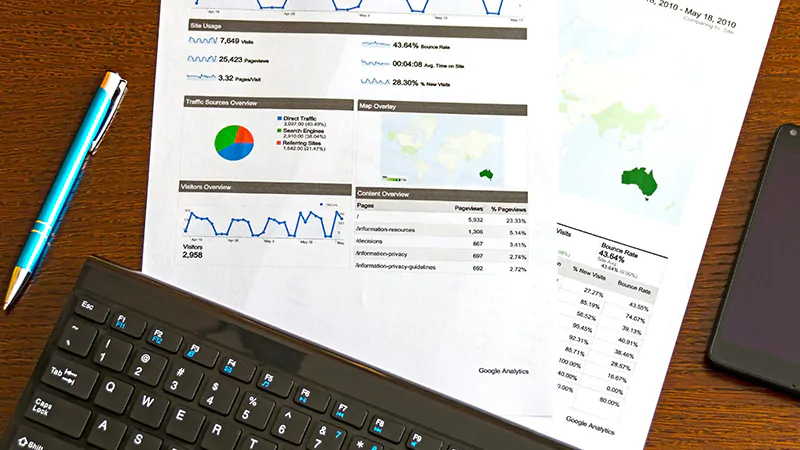The ocean of data within Google Analytics holds more than just mere statistics; it grips a world of hidden treasures waiting to be uncovered. And the time has come to embark on an epic quest to reveal the true power of this technology. With the help of Custom Reporting, you’ll be able to delve into the depths of Google Analytics 4 and extract insights that have the potential to transform your marketing and website optimization efforts.
Uncover GA’s Secrets supermetrics – Join Us Today!
GA4: The Key to Data Mastery
For those who work in Google Analytics, tracking events, campaigns, and conversions is a common task. However, just a single click away lies a feature-rich area that can enhance data collection and analysis. The “Admin” screen is usually accessed by analytics professionals and those responsible for data collection, but marketers can also benefit from familiarizing themselves with its capabilities.
Exploring the Admin screen involves discovering property settings for account governance, attribution, reporting improvement, and overall user tracking. Here are three key things to keep in mind regarding Google Analytics 4 account governance:
In Google Analytics, a property refers to the location where web or app data is collected and reported. Currently, there are two types of properties – Google Analytics 4 and the previous version, Universal Analytics (often referred to as “GA3”). Universal Analytics will no longer accept data by July 2023, so all marketers should be migrating or have already migrated to GA4.
To determine if it’s the old version, look for the property ID. It can be found under the property name in the main dropdown or in parentheses in the Admin > Property column. If the ID begins with “UA” and resembles “UA-12345-1,” then it’s not a GA4 property.
Universal Analytics IDs are tracking IDs and should be placed on the website or in a tag manager for data collection. If you encounter missing data or broken tracking, review the data source or add the necessary information. For GA4, you’ll need a “measurement ID.”
Moreover, properties in GA4 do more than simply house data and reports.
Property settings and governance can impact remarketing capabilities, data integrity, and conversion interpretation. Some dimensions that can help improve search engine marketing campaigns include Query Word Count, Query Match Type, Revenue per Click, ISO Week of the Year, Day Index, Minute, Hostname, and Second Page.
For example, Query Word Count categorizes clicks and other metrics by words in user search queries and can be used to construct histograms and track conversion metrics. Query Match Type offers information on the exact match, phrase match, or broad match between a query and keyword, while Revenue per Click calculates the value of each keyword based on revenue and profit/margin. ISO Week of the Year reports weeks starting from Monday, while Day Index provides insights into customer behavior by the minute.
Hostname is useful for reporting on multiple subdomains with the same URI, and Second Page helps analyze the user journey on the second page of a visit.
Always remember, data is just a summary of thousands of stories!
Hidden GA Gems: Making the Most of Analytics
Days since last session and date of 1st session are two important custom dimensions in Google Analytics that can be used to analyze lapsed users and user behavior.
Days since last session helps you in identifying disengaged users and create a segment to reactivate their engagement, while date of 1st session allows you to define a date range for the user’s first interaction with your website and create a segment for remarketing with specific messaging.
An effective analytics implementation relies on a well-structured account, which involves making decisions about data flow into different possessions. This is particularly important for multiple websites and apps, as well as for websites with multiple domains and Google Analytics 360 customers.
As well, to ensure data integrity, it’s essential to consider cross-domain tracking when users navigate back and forth between fields. Incorporating a feature for more granular data, such as subsets of data, is highly recommended for almost all organizations and can be done easily through the creation of subproperties in the Google Analytics Admin area.
Supermetrics Google Sheets Add-on also helps you uncover hidden insights in your data.
Well, if you can’t measure it, you can’t improve it!

Rolling Up Google Analytics 4 accounts: Enhancing Data Insights
In Google Analytics 4, there is an option to aggregate data from multiple GA4 accounts into a single holistic rollup asset.
The sites area in GA4 also offers other administrative capabilities. To get the most out of media metrics and audiences, it’s important to integrate Google Ads with GA4. This can be done easily through the Admin area, where integrations are located at the bottom of the property column. To link, all that’s required is having the Edit role in GA4 and the role of Administrator in Google Ads.
Once linked, audiences created in GA4 will be automatically available in Ads.
Besides, to ensure optimal data collection, also be sure to check and enable the toggles for Google Signals and Ads Personalization in the Admin > Data Settings area.
Double-check with the GA administrator (if not yourself) to make sure these settings align with your privacy policies.
Keep in mind, to access these dimensions; both the Google Analytics and AdWords accounts must be linked!
In conclusion, GA4 implementation requires collaboration between marketers and analytics, but with a few simple settings, toggles and property reviews, the results can be valuable. Having accurate data and enabling media tracking opens up opportunities for audience creation, providing deeper insights to inform decision-making. With the help of the Google Analytics 4 Setup Assistant, marketers can start utilizing the power of GA4 to redefine success.
As Geoffrey Moore, an American business writer, said: “Without big data analytics, companies are blind and deaf, wandering out onto the web like deer on a freeway”.



